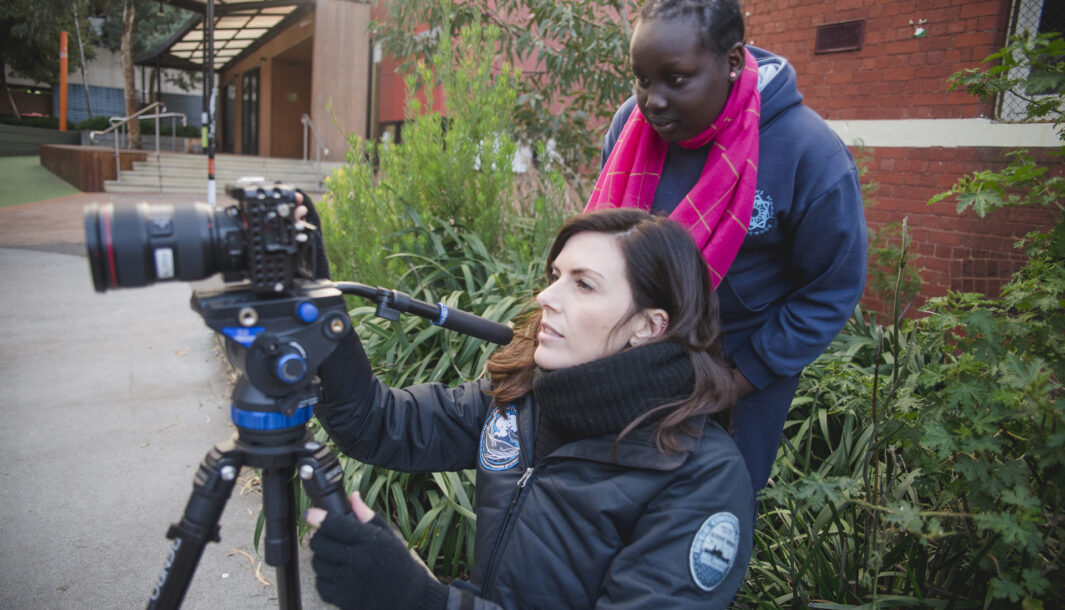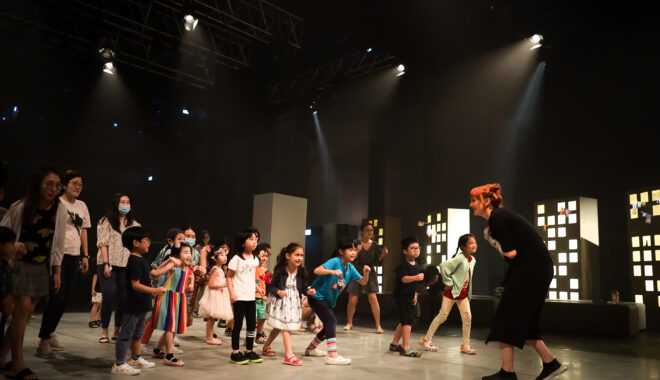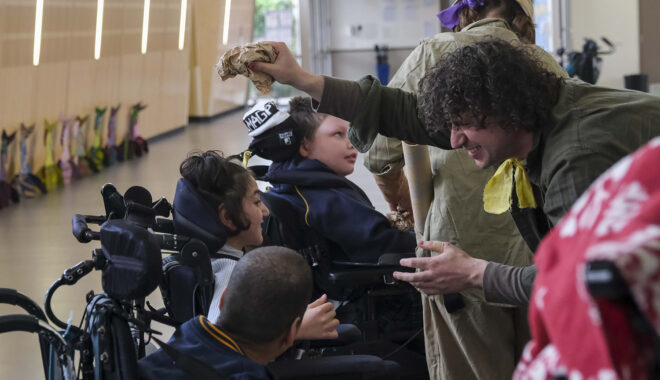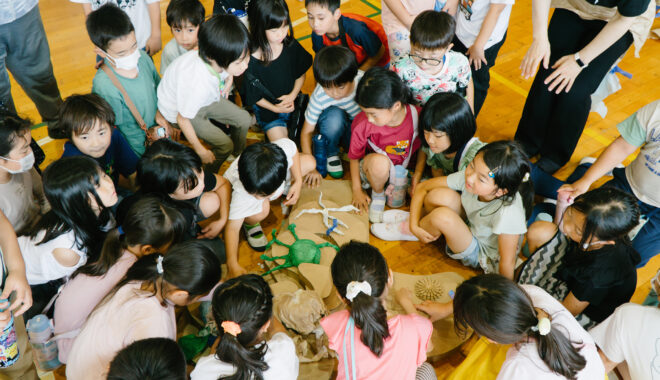15 Jul 2019 Education News
Education resources and child-led practice: a discursive entanglement

By Meg Upton
It is early morning before the first bell. A large cardboard forest has appeared as if by magic in the multi-purpose room. Faces appear at the window, noses pressed against glass, and deeply curious expressions let the artists know children are ready for adventure, ready to reshape and reimagine the forest as their own.
On another day in another school, the final bell has rung, and 5678 Film Club participants are scattered in small production groups around the library. They’re making films, but for now they’re telling stories, trying to decide on “the one”, the best story, the story that will become their film.
Child-led art making
Polyglot’s philosophy and method of child-led art making is at the centre of their artistic practice. Creating education resources that in some way represent that process is a wonderful opportunity, but can also be challenging. Education resources often get a bad rap as being too prescriptive, not prescriptive enough, not promoting a sense of curiosity, a discomfort with ambiguity, or denying young people the opportunity to feel content with their own meaning making (Reason, 2010; Upton, 2016). Resources created to champion ambiguity – what it feels like to feel uncertain and to not really mind – to prompt curiosity, and initiate creative inquiry for students, and teachers, can be a powerful partner to a performance or arts experience. They introduce, extend, challenge and enable critical reflection. They can offer opportunities for educators to firmly embed the arts into teaching and learning programs.
Caretakers of child-led practice
Sinclair et al (2017) believe the arts are so important they should be at the centre of the primary school curriculum, and I agree. Education resources for Polyglot always consider the deep importance of the arts in learning, especially how teachers can become both the caretakers of a Polyglot experience and the creative facilitators of new child-led arts experiences in the classroom. Quality arts experiences respond to “the need for creativity and flexibility” and are “must-haves” for those who wish to make sense of 21st century living”. Quality arts experiences and arts education enable teachers to “provide creative activities for their students [including] those with special needs, problem-solving strategies and methods of authentic assessment” (Ewing, 2011, p. 2-4).
Schools and schooling are often constrained by structures and standardisation (Tait, 2015). While Polyglot programs have both design and structure, they do so in a way that responds to the children who are participating, at any given moment and with authenticity. For teachers in the classroom who are introducing or extending the Polyglot experience, using the approach taken in the education resource can require a shift in thinking, and feeling comfortable with children leading the creative process, one which is potentially chaotic and messy.
At the same time an education resource needs to respond to educational and learning imperatives, to acknowledge and embed the curriculum, key learning areas, and capabilities including literacy, personal and social, intercultural, ethical, and critical and creative thinking. The “messiness” and processes of child-led art making and the need to address curriculum and learning outcomes creates the challenges and tensions I spoke of earlier.
Creating a resource
The beginning point of creating a resource for Polyglot is my own immersion in the selected arts program. To reflect a child-led approach means to witness the arts program in the contexts where students experience it and to see, hear and feel the artists – the children and the Polyglot team – in action. This is an approach I have always taken to creating education resources, believing that deep witnessing and, whenever possible, participation enable me to develop a resource that connects meaningfully to the intentions and aesthetics of the arts experience, also recognising the structures that can shape a classroom learning environment – time, resources, space, diversity, inclusion – and the curriculum. The two projects featured in the introduction, Paper Planet and 5678 Film Club, are examples of this approach. Importantly, a resource should seek to capture the voices of young people as the initiators, creators and artists.
The resource that has recently been created for 5678 Film Club uses film as a medium for learning about film making. Participants in 5678 are film industry “experts” who work with film making creatives to guide students and teachers through a process of how to create a film using simple digital devices and processes. The resource adopts the child-led approach inherent in the 5678 Film Club project and embeds it in the resource. So, kids speak to kids (and teachers), and they pass on their experiences and knowledge of film making using the creative medium they engaged with.
In the education resource for Paper Planet, children imagine a planet, then one made of paper, cardboard, and tape, and teachers facilitate the creation of a paper planet in the classroom using these materials. Children engage with their senses, and immerse themselves in that world through character, story and play, and engage with multiple forms of literacy. The Polyglot Paper Planet installation experience immerses children deeply, and the resource suggests how the classroom space can one for extending the creative and imaginative experience – what did they imagine, what did they experience, what do they remember, what next – and is it possible to leave it like that for days, even weeks???
In essence, my mission is to create resources that position learners at the centre, ask questions rather than offer answers, trust young people and educators to be comfortable with ambiguity and to be offered ways to find their own meaning. Sometimes I think of the process of creating an education resource as an act of translation or, as I sometimes call it, a “discursive entanglement”, one that aims to bring the languages of the arts and the languages of education together in a creative and meaningful way. It’s a great metaphor for working with a company called Polyglot!
Resources and further reading
- Ewing, R. (2011). The Arts and Education: Realising Potential, Australian Education Review.
- Kalantzis, M. & Cope, B. (2012). Introduction – The work of learning and teaching literacies, Literacies, UK: Cambridge University Press, pp 1-18
- Nicholson, H. (2009). Theatre and Education. UK: Palgrave MacMillan
- Reason, M. (2010). The Young Audience: Exploring and enhancing children’s experiences of theatre. UK: Trentham Books
- Sinclair, C., Jeanneret, N., O’Toole, J. & Hunter, M. (2017). Education in the Arts (3rd Ed). Australia: Oxford University Press
- Sefton-Green, J., Thomason, P., Jones, K & Bresler, L. (2011). The Routledge International Handbook of Creative Learning, UK: Routledge
- Tait, G. (2016). Making Sense of Mass Education (2nd ed). Australia: Cambridge University Press
- Upton, M. (2016). The Provocative Space: Deepening Students’ Experience of Live Theatre in Schonmann (Ed.) International Yearbook for Research in Arts Education, Germany: Waxmann, pp. 268-272.
Biography
Meg Upton is an arts educator, teaching artist and researcher. She has a PhD in drama education, currently teaches and researches in the School of Education at Deakin University, and has previously held positions as education manager with Malthouse Theatre and Melbourne Theatre Company. Meg has researched and created over one hundred education resources for arts and other organisations, winning several awards, and is the author of Currency Press Platform paper, Education and the Arts: Creativity in the Promised New Order (with Naomi Edwards). Her current research focuses on young people, the arts and critical feeling.







